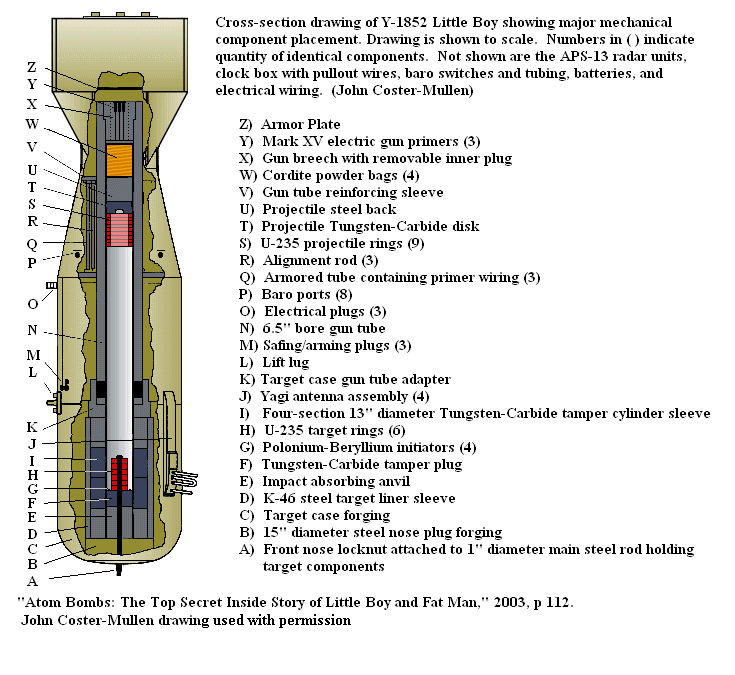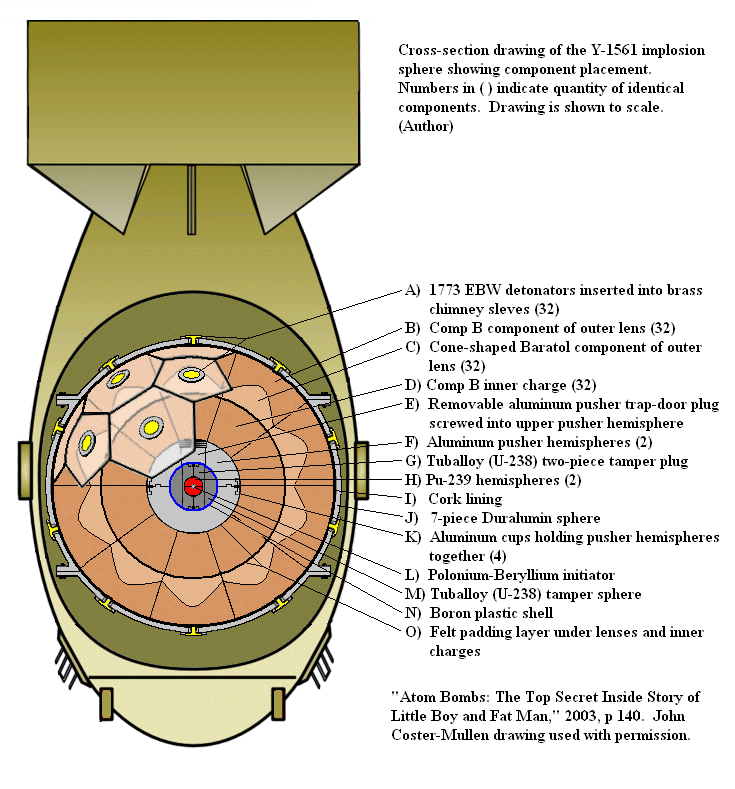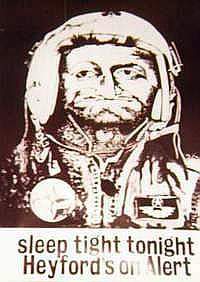Winston
Lorenzo von Matterhorn
- Joined
- Jan 31, 2009
- Messages
- 9,560
- Reaction score
- 1,748
First, the book I received just today via inter-library loan is fantastic:
Atom Bombs: The Top Secret Inside Story of Little Boy and Fat Man
https://www.amazon.com/dp/B0006S2AJ0/?tag=skimlinks_replacement-20
Extremely detailed and well referenced, full of images I've not seen before (and I've seen a lot).
The highly respected amateur nuke sleuth, Chuck Hansen, who did the same as the author of the above via the same method of interviews and correlation of massive amounts of declassified data (including reams of it that maybe shouldn't have been declassified because of the ability to "connect the dots") wrote the excellent book:
US Nuclear Weapons: The Secret History
https://www.amazon.com/dp/0517567407/?tag=skimlinks_replacement-20
However, Hansen's less detailed Little Boy diagram is apparently significantly wrong. Given the referenced material used by John Coster-Mullen, his diagram is correct:

From the diagram and info in the text, I'd guess you're probably 80% along the way to building one assuming you had the nuclear materials and the extensive machining capabilities. The gun type U235 device is one heck of a lot more difficult to carry out in practice than I'd previously believed, but it's still much easier that a spherical implosion device. By lucky accident, U235 is difficult to produce (mass separation) while the device based upon it is the easier one to build, while Pu239 is much more easy to produce (chemical separation), but the device based upon it is much more difficult to build. Thus, the North Korean "successes" thus far with Pu239 devices that have produced estimated 6kt yields (approx. 28% of what it should be for an unboosted device) and the Iranian decision to go with the more difficult U235 centrifuge separation process to end up with a bomb that will actually work to full yield relatively easily, but be less efficient than an implosion device could be.
Of the diagrams of the Fat Man implosion device and its description, John Coster-Mullen's work is much more detailed than any I've seen before, including Hansen's. Once again, here's Coster-Mullens work:

Interesting tidbits from my first scan of the book's first chapters:
The two secretive guys who transported the mysterious cargo (Little Boy's U235 components) to Tinian Island on-board the Indianapolis claimed to be artillery officers... but they were both wearing their collar insignia upside down. No one mentioned it...
The aluminum positives used to create the bismuth alloy ceramic molds for the Fat Man's explosive lenses required the use of a unique for that era numerically controlled mill owned by Chrysler Corp. It's use in that task required shutting down for three days the B29 engine line on which it was normally used.
All of the ballistic components for Little Boy had been tested using U238. Many target casings shattered or cracked. After each test, a Caterpillar D8 bulldozer was used to pull the nested, press fit, and bolted components apart. The machined ballistic related components of the bomb were all finely machined and highly polished including all internal surfaces and were "beautiful to look at."
The Little Boy gun device had no impact fusing unlike the Fat Man device. Tests in drops from 30k feet indicated that the U235 projectile would slide forward down the smooth bore barrel at impact and detonate the device, perhaps not to full yield, but far more than enough to prevent capture of a mostly intact device.
Next, a great nukes web site front page:
https://blog.nuclearsecrecy.com/
Some interesting articles and resource links found there:
The Third Core’s Revenge
https://blog.nuclearsecrecy.com/2013/08/16/the-third-cores-revenge/
Kilotons per kilogram
https://blog.nuclearsecrecy.com/2013/12/23/kilotons-per-kilogram/
Web-based Primary Sources for Nuclear History
https://blog.nuclearsecrecy.com/2011/11/14/web-based-primary-sources-for-nuclear-history/
Finally, nuke your target of choice (now new and improved with airburst capability!):
https://www.nuclearsecrecy.com/nukemap/
[video=youtube;Y7plCC0ZE6w]https://www.youtube.com/watch?v=Y7plCC0ZE6w[/video]
Atom Bombs: The Top Secret Inside Story of Little Boy and Fat Man
https://www.amazon.com/dp/B0006S2AJ0/?tag=skimlinks_replacement-20
Extremely detailed and well referenced, full of images I've not seen before (and I've seen a lot).
The highly respected amateur nuke sleuth, Chuck Hansen, who did the same as the author of the above via the same method of interviews and correlation of massive amounts of declassified data (including reams of it that maybe shouldn't have been declassified because of the ability to "connect the dots") wrote the excellent book:
US Nuclear Weapons: The Secret History
https://www.amazon.com/dp/0517567407/?tag=skimlinks_replacement-20
However, Hansen's less detailed Little Boy diagram is apparently significantly wrong. Given the referenced material used by John Coster-Mullen, his diagram is correct:

From the diagram and info in the text, I'd guess you're probably 80% along the way to building one assuming you had the nuclear materials and the extensive machining capabilities. The gun type U235 device is one heck of a lot more difficult to carry out in practice than I'd previously believed, but it's still much easier that a spherical implosion device. By lucky accident, U235 is difficult to produce (mass separation) while the device based upon it is the easier one to build, while Pu239 is much more easy to produce (chemical separation), but the device based upon it is much more difficult to build. Thus, the North Korean "successes" thus far with Pu239 devices that have produced estimated 6kt yields (approx. 28% of what it should be for an unboosted device) and the Iranian decision to go with the more difficult U235 centrifuge separation process to end up with a bomb that will actually work to full yield relatively easily, but be less efficient than an implosion device could be.
Of the diagrams of the Fat Man implosion device and its description, John Coster-Mullen's work is much more detailed than any I've seen before, including Hansen's. Once again, here's Coster-Mullens work:

Interesting tidbits from my first scan of the book's first chapters:
The two secretive guys who transported the mysterious cargo (Little Boy's U235 components) to Tinian Island on-board the Indianapolis claimed to be artillery officers... but they were both wearing their collar insignia upside down. No one mentioned it...
The aluminum positives used to create the bismuth alloy ceramic molds for the Fat Man's explosive lenses required the use of a unique for that era numerically controlled mill owned by Chrysler Corp. It's use in that task required shutting down for three days the B29 engine line on which it was normally used.
All of the ballistic components for Little Boy had been tested using U238. Many target casings shattered or cracked. After each test, a Caterpillar D8 bulldozer was used to pull the nested, press fit, and bolted components apart. The machined ballistic related components of the bomb were all finely machined and highly polished including all internal surfaces and were "beautiful to look at."
The Little Boy gun device had no impact fusing unlike the Fat Man device. Tests in drops from 30k feet indicated that the U235 projectile would slide forward down the smooth bore barrel at impact and detonate the device, perhaps not to full yield, but far more than enough to prevent capture of a mostly intact device.
Next, a great nukes web site front page:
https://blog.nuclearsecrecy.com/
Some interesting articles and resource links found there:
The Third Core’s Revenge
https://blog.nuclearsecrecy.com/2013/08/16/the-third-cores-revenge/
Kilotons per kilogram
https://blog.nuclearsecrecy.com/2013/12/23/kilotons-per-kilogram/
Web-based Primary Sources for Nuclear History
https://blog.nuclearsecrecy.com/2011/11/14/web-based-primary-sources-for-nuclear-history/
Finally, nuke your target of choice (now new and improved with airburst capability!):
https://www.nuclearsecrecy.com/nukemap/
[video=youtube;Y7plCC0ZE6w]https://www.youtube.com/watch?v=Y7plCC0ZE6w[/video]
Last edited by a moderator:






